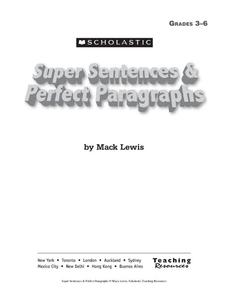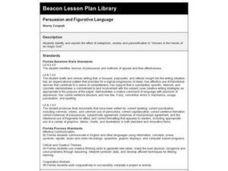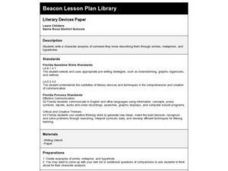Curated OER
Similes, Metaphors, and Symbols
Here is an outline of a lesson in which learners examine the use of similes, metaphors, and symbols in poetry. They define similes, metaphors, and symbols, complete a handout, and create a poem using types of figurative language.
Curated OER
Fruit Writing
Students who have recently learned about similes and metaphors practice putting them in their writing. They get a better understanding of how similes and metaphors can be used by practicing the usage of them in their own personal...
Curated OER
Spring Similes
Students write similes with a partner. In this spring similes lesson plan, students discuss the season an write a story using a minimum number of similes.
Curated OER
Poetry Notes
Break this presentation into two or three days so as not to overwhelm your kids. Fifty-four slides is a lot of slides, but the PowerShow is well-organized, and terms are defined clearly and illustrated in examples provided. A general...
Curated OER
A Lucky Break
Explore idioms with a chicken theme! Consider doing these activities prior to Thanksgiving, as there's a section about wishbones! First your youngsters will match a short list of idioms with their meanings. Then, give each learner the...
Curated OER
Literary Terms
Seriously, 93 slides of literary terms? Yes, and well worth the time, although perhaps not all at once. The beauty here is in the concise, easy-to-understand definitions for such well-known terms as imagery and personification, as well...
Curated OER
Poetry Passport
Passport photos are notoriously unflattering but here's an activity that encourages youngsters to create a poetic picture of themselves using each category on the passport as a prompt for a poem.
Novelinks
Tunes for Bears to Dance to: Concept Analysis
Considering using Robert Cormier's young adult novel, Tunes for Bears to Dance to for book circles or as a whole-class anchor text? Check out this overview of the key concepts and issues raised by the novel.
Penguin Books
Teacher's Guide: I Know Why the Caged Bird Sings by Maya Angelous
Maya Angelou's I Know Why the Caged Bird Sings is controversial. Like many other Angelou books, it is frequently challenged or banned from schools. In fact, Angelou is one of the most frequently banned authors in the United States. An...
K20 LEARN
Criminal Motivations: Irony and Characterization In "The Cask Of Amontillado"
Edgar Allan Poe's short story "The Cask of Amontillado" is a bit of a puzzle. Critics have long debated Montresor's motives for killing Fortunato. Young scholars examine examples of the three types of irony (verbal, dramatic, and...
K20 LEARN
Lord of the Flies Unit, Lesson 1: I'm A Survivor
What three readily available things would you grab in case of an emergency? That's the question that launches a unit study of William Golding's The Lord of the Flies. After sharing their choices, class members read Golding's rationale...
K20 LEARN
Where I'm From: Poetry
We carry memories of where we're from; tweens and teens can capture these memories by first listening to several memory poems and then crafting their own. They analyze literary devices other poets use, brainstorm a list of images they...
Teachers.net
Figurative Language
When is a staple remover a fanged monster? In your ELA classroom when you're teaching this fun figurative language instructional activity, of course! Get your young writers using figurative language by making a game of it. Give groups a...
Scholastic
Super Sentences & Perfect Paragraphs
An extensive collection of lessons and activities includes many writing, grammar, and proofreading exercises. With templates and worksheets that cover several steps in the writing process, from sentence to paragraph to essay, this...
Curated OER
Comments WERD
Students examine several examples of similes and metaphors, stating what is being compared. Then each student chooses a different person from the Civil War era and writes similes and metaphors that describe that person.
Curated OER
No Title
Fourth graders, after brainstorming a list of things good friends do for each other, apply prereading strategies to the book, "Be A Friend to Trees," and create similes and metaphors utilizing content ideas. They also sketch an...
Curated OER
A Rose Is a Rose
Flowering learners explore the concept of figurative language as it relates to poems, songs, or creative written expression. In this creative writing lesson, they complete several phrases using similes, metaphors, and personifications. ...
Curated OER
No Title
Fourth graders identify examples of figurative language in the book, "One Day in the Woods," by Jean Craighead George. They illustrate a figure of speech and identify it as a simile or metaphor. Each student then records their...
Curated OER
Patterns In Poetry: Images (Part 3)
Students explore imagery in poetry. For this poetry lesson, students examine how the use of metaphors and similes aid in reading comprehension. Multiple resources are provided.
Curated OER
Tuck Everlasting Unit
Natalie Babbitt's award winning fantasy, Tuck Everlasting, is the anchor text in a unit plan that focuses on identifying similes, metaphors, imagery, and personification in the text and analyzing how these elements effect the development...
Curated OER
Identifying Figurative Language
Students explore figurative language. In this Fahrenheit 451 activity, students read the Bradbury novel. As they read, students note the simile, metaphor, and personification examples that they encounter.
Curated OER
Persuasion and Figurative Language
Students study and discuss definitions of metaphor, simile, and personification. In small groups, they read a section of "Sinners in the Hands of an Angry God" and identify those devices. The group presents their examples with the class.
Curated OER
Literary Devices Paper
Fourth graders write a character analysis of someone they know describing them through similes, metaphors, and hyperboles. They may include themselves and how their person relates to him or her.
Curated OER
"How to Eat a Poem"
Eighth graders write a poem showing what they know about metaphors, and non-literal language to express ideas, convey meaning, and create images after they read Eve Merriam's "How to Eat a Poem".

























